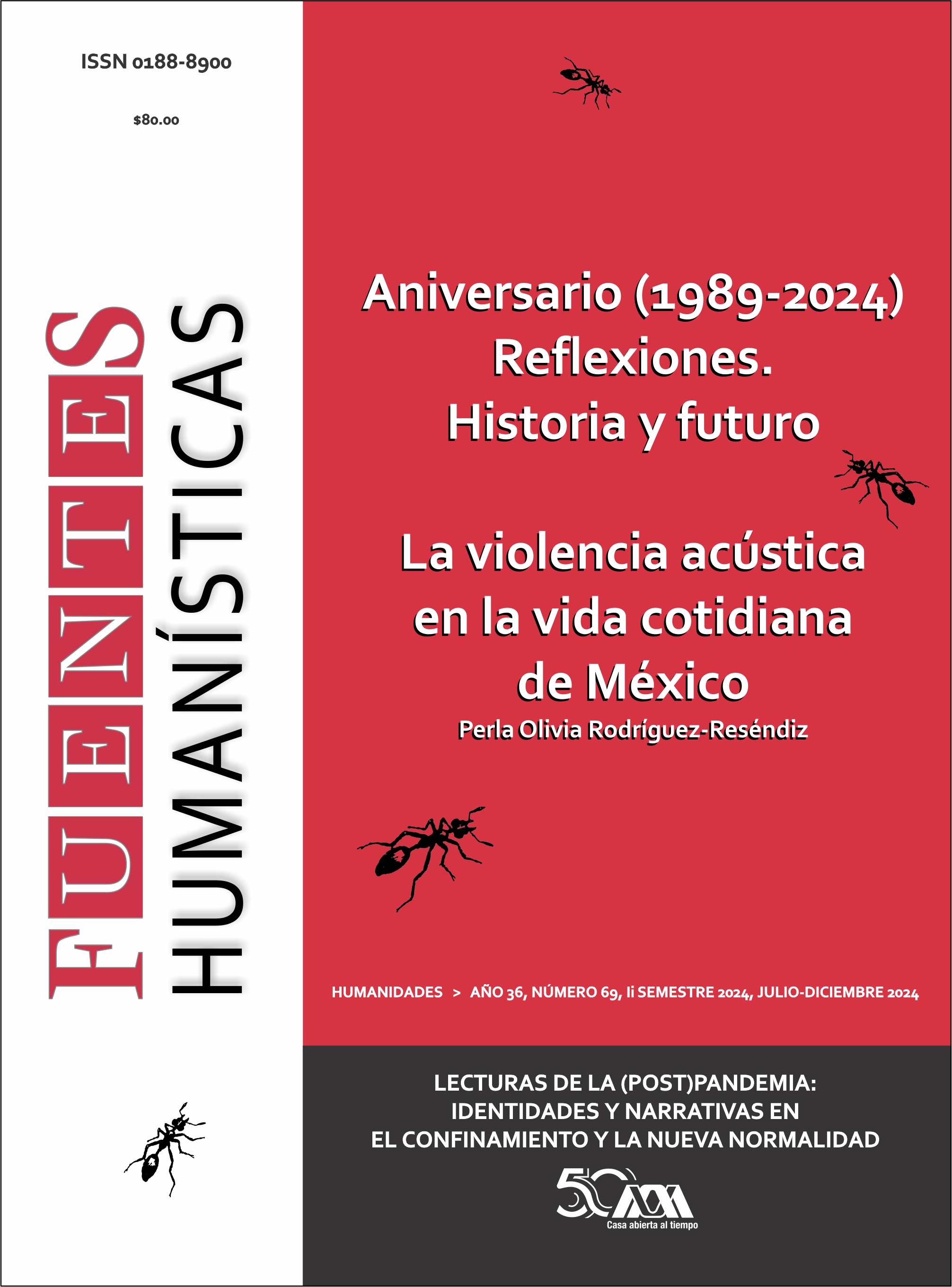The Social Representation of Indigenous People in Mexican Cinema: a Diachronic Study
Abstract
This paper examines language from a sociolinguistic and discursive pragmatic perspective, focusing on how cinema represents sociohistorical realities related to indigenous people. We conducted a historical review of indigenous issues movies, discovering that indigenous people continue to be insulted, discriminated against, underestimated, and socially distanced.Downloads
References
Arciga B., Salvador. (2004). Representación social. En Eulogio Romero Rodríguez (Ed.), Representaciones sociales. Atisbos y cavilaciones del devenir de cuatro décadas. Benemérita Universidad Autónoma de Puebla.
Bolcatto, Andrea. (2003). Una mirada sobre las representaciones sociales en el cine documental. Claroscuro III(3).
Curiel, Federico. (1968). María Isabel. Películas Rodríguez. Recuperada de YouTube https://youtu.be/VSZ8smfI3S0?list=TLPQMjYwNDIwMjPJULP1pLdug el 17 de noviembre del 2022.
De Alba, Martha. (2004). De las representaciones colectivas a las representaciones sociales: algo más que un cambio de adjetivo. En Eulogio Romero Rodríguez (Ed.), Representaciones sociales. Atisbos y cavilaciones del devenir de cuatro décadas. Benmérita Universidad Autónoma de Puebla.
De la Peña, Francisco. (2014). Imaginarios fílmicos, cultura y subjetividad. Por una antropología del cine. ENAH-INAH-Ediciones Navarro.
Diezmartínez, Ernesto. (2015). El racismo en el cine mexicano. Letras libres, 204.
Fernandez, Emilio. (1948). Río escondido. Producciones Raúl de Anda. Recuperada de YouTube https://youtu.be/Y7n5quMRMA el 16 de mayo del 2022.
Guimelli, Christian. (2004). El pensamiento social. Dirección General de Asuntos del Personal Académico/unam-Coyoacán.
Ibarra M., Fausto Enrique. (2003). Historia del cine en Hermosillo, Sonora: período (1900-2002) [Tesis de licenciatura, Universidad de Sonora]. Biblioteca Digital, Colecciones digitales, Tesis digitales.
Jiménez Merino, Juan Manuel. (2019). El indígena en el cine mexicano: un breve recorrido. En Carlos Oliva y Luis Guillermo Martínez (Comp.), Cine mexicano y filosofía). Universidad Autónoma de México/Ítaca.
Jiménez Marcos, Rebeca. (2019). Resignificar al otro: folclorización del indígena en el cine mexicano. En Carlos Oliva y Luis Guilermo Martínez (Comp.), Cine mexicano y filosofía. Universidad Autónoma de México/ Ítaca.
Martins, Inés y Faria, Juliana Guimarães (2019). Cine, representación social y educación. Série-Estudos, 24(51). htt ps://doi.org/10.20435/serie-estudos. v24i51.1295
Molina Ríos, Juliana Angélica y Romero Chala, Bibiana Yaneth. (2012). Lectura y escritura de las representaciones sociales: hacia la conformación de una postura crítica en la educación superior, enunciación 17(1).
Navarro, Carlos. (1935). Janitzio. Crisósforo Peralta Jr. Recuperada de YouTube https://youtu.be/FICGhOoCiUs?list=RDQMUXBj9oLXCJw el 16 de mayo del 2022.
Novaro, Tito. (1984). Ni Chana, ni Juana. Producciones Matouk. Recuperada de YouTube https://youtu.be/_bmxv2DpIRY el 24 de noviembre del 2022.
Olhovich, Sergio. (1977). Llovizna. Conacine y Dasa Films. Recuperada de YouTube https://youtu.be/3CH-EFlpjgA el 18 de noviembre del 2022.
Quemada-Díez, Diego. (2013). La jaula de oro. Animal de Luz Films, Castafiore Films, Consejo Nacional para la Cultura y las Artes (Conaculta), Eficine, Estudios Churubusco Azteca S.A., Instituto Mexicano de Cinematografía (imcine), Kinemascope Films, Machete Producciones. Recuperada de Facebook https://www.facebook.com/Sanjuanamecacpuebla/videos/jaula-de-oro/624537591533773/ el 18 de abril de 2023.
Raiter, Alejandro; Sanchez, Karina y Zullo, Julia. (2002). Representaciones sociales. Editorial niversitaria de Buenos Aires, Argentina.
Rodríguez, Ismael. (1957). Tizoc, amor indio. Antonio Matouk Recuperada de YouTube https://youtu.be/Wb97f9sSvIM el 8 de noviembre del 2022.
Rodríguez, Ismael. (1961). Ánimas Trujano. Azteca Films. Recuperada de YouTube https://youtu.be/iBKblP0NOIs?list=TLPQMjYwNDIwMjPJULP1pLdug 18 de noviembre del 2022.
Sala, Xavi. (2018). El ombligo de Guie’dani. Xavi Sala p.c. Recuperado de Internet Archive https://archive.org/details/el-ombligo-de-guiedani-2018480p/02_Xquipi’+Guie’dani+(El+omb ligo+de+Guie’dani)+(2018%2C480p).m4v el 4 de mayo de 2023.
Van Dijk, Teun. (1998). Ideología: un enfoque multidisciplinario. Gedisa.
Van Dijk, Teun; Ting-Toomey, Stella; Smitherman, Geneva y Troutman, Denise. (2000). Discurso, filiación étnica, cultura y racismo. En Teun van Dijk (Coord.), El discurso como interacción social: estudios sobre el discurso II: una introducción multidisciplinaria. Gedisa.
Van Dijk, Teun (2001). El análisis crítico del discurso y el pensamiento social, Atenea Digital, 1. Disponible en http://blues.uab.es/athenea/num1/vandijk.pdf (22/06/2012)
Van Dijk, Teun. (2008). Discurso y contexto: un enfoque sociocognitivo. Cambridge University Press.
Velasco María, Elena. (1993). Se equivocó la cigüeña. Televicine S. A. de C. V. Recuperada de YouTube https:// youtu.be/VdGLcUmRviA el 14 de marzo del 2023.

This work is licensed under a Creative Commons Attribution-NonCommercial-ShareAlike 4.0 International License.
Authors who publish in this journal accept the following conditions:
Fuentes Humanísticas is licensed under a Creative Commons Attribution-NonCommercial-ShareAlike 4.0 International (CC BY-NC-SA 4.0) license.
Authors retain copyright and grant the journal the right of first publication, with the work licensed under the Creative Commons Attribution license CC BY-NC-SA 4.0, which allows third parties to:
Share — copy and redistribute the material in any medium or format.
Adapt — remix, transform, and build upon the material.
The licensor cannot revoke these freedoms as long as you follow the license terms.
Under the following terms:
Attribution — You must give appropriate credit, provide a link to the license, and indicate if changes were made. You may do so in any reasonable manner, but not in any way that suggests the licensor endorses you or your use.
NonCommercial — You may not use the material for commercial purposes.
ShareAlike — If you remix, transform, or build upon the material, you must distribute your contribution under the same license as the original.
No additional restrictions — You may not apply legal terms or technological measures that legally restrict others from doing anything the license permits.
Authors may enter into other independent and additional agreements for the non-exclusive distribution of the published version of the article in this journal (e.g., placing it in an institutional repository) as long as they clearly indicate that the work was first published in this journal.










